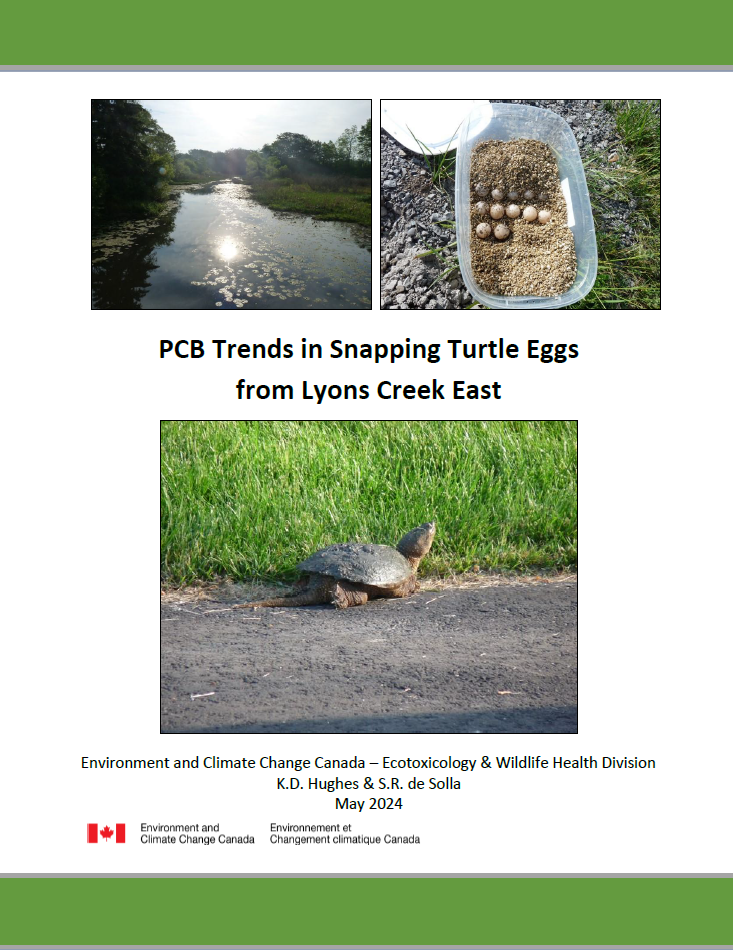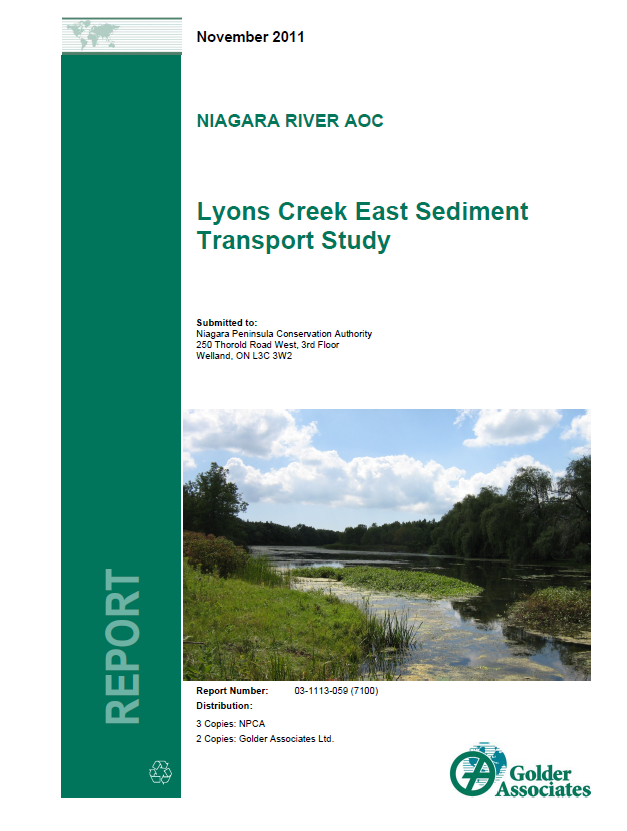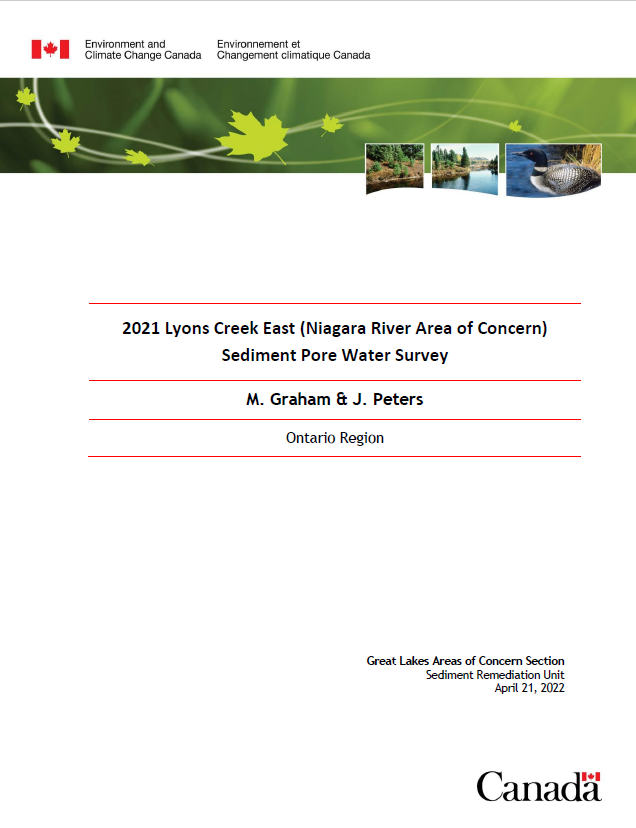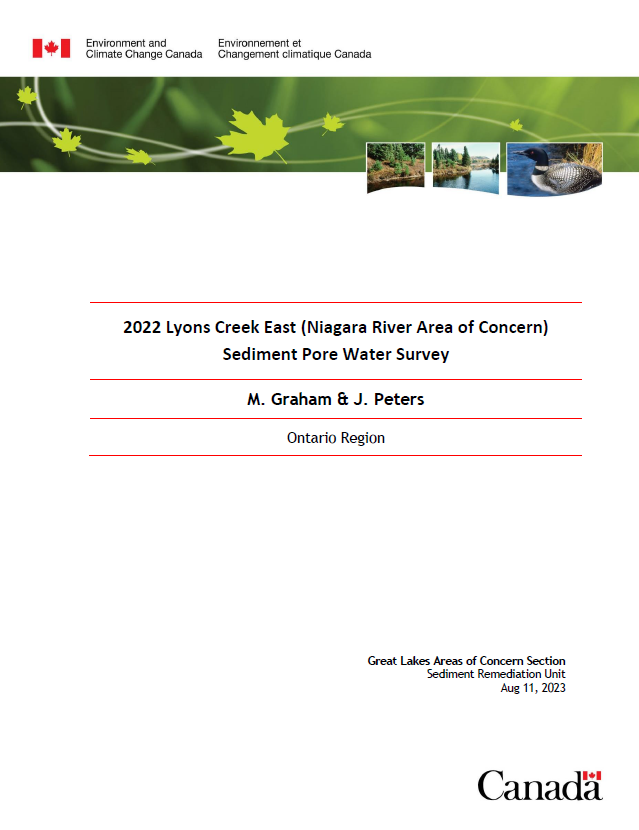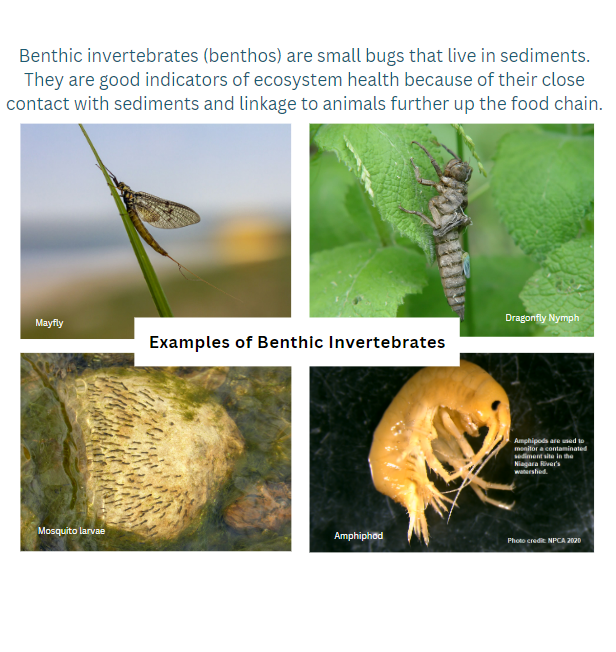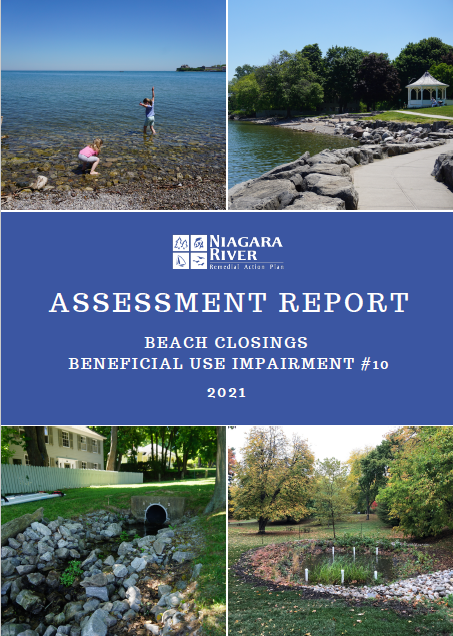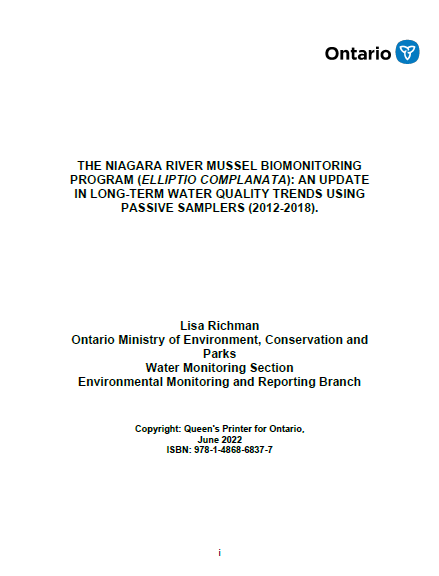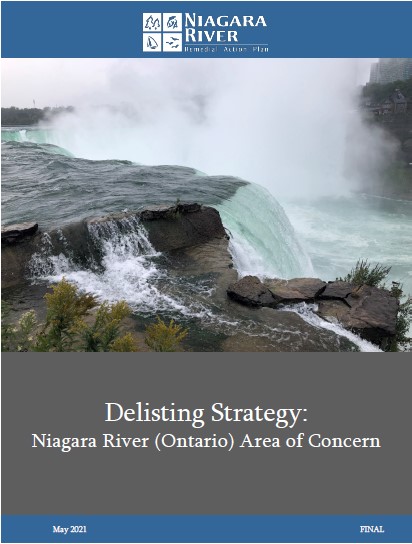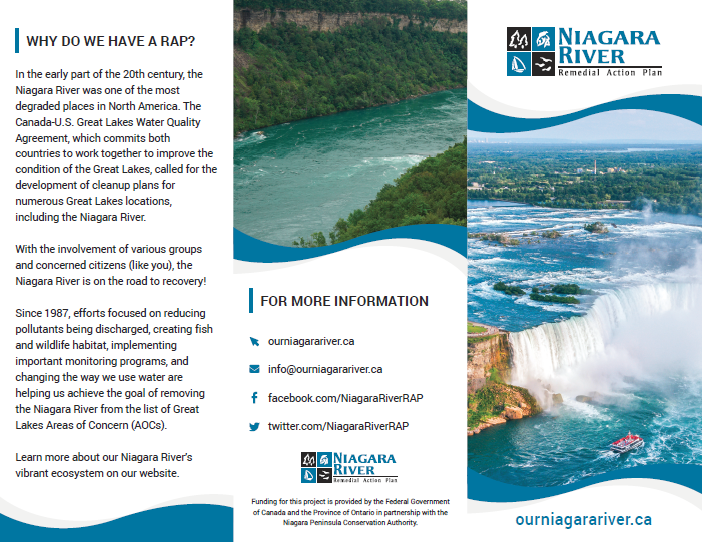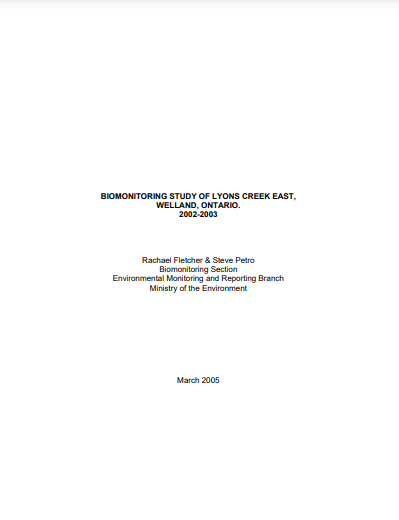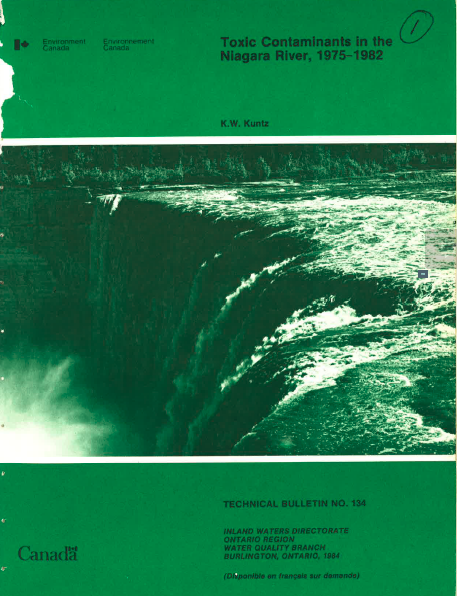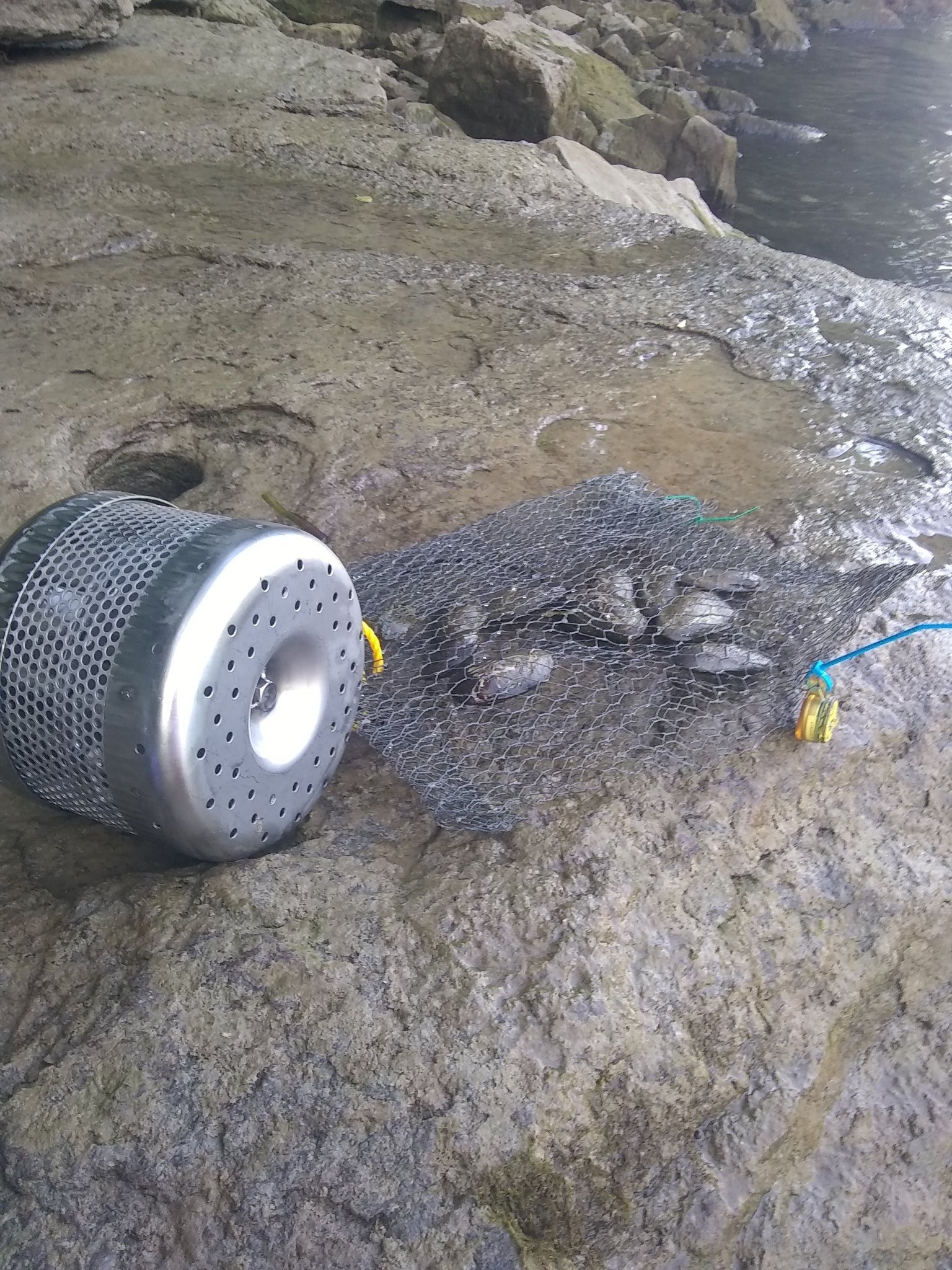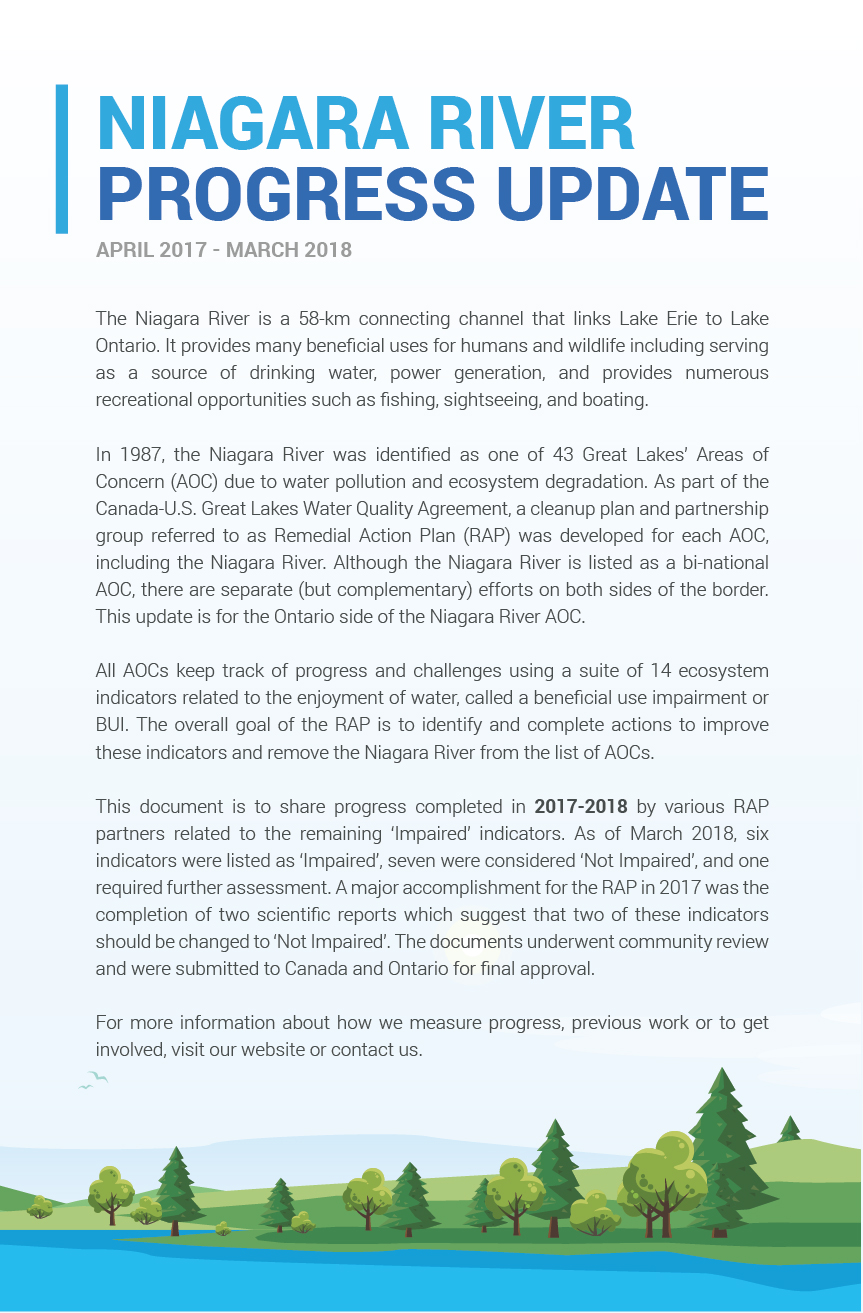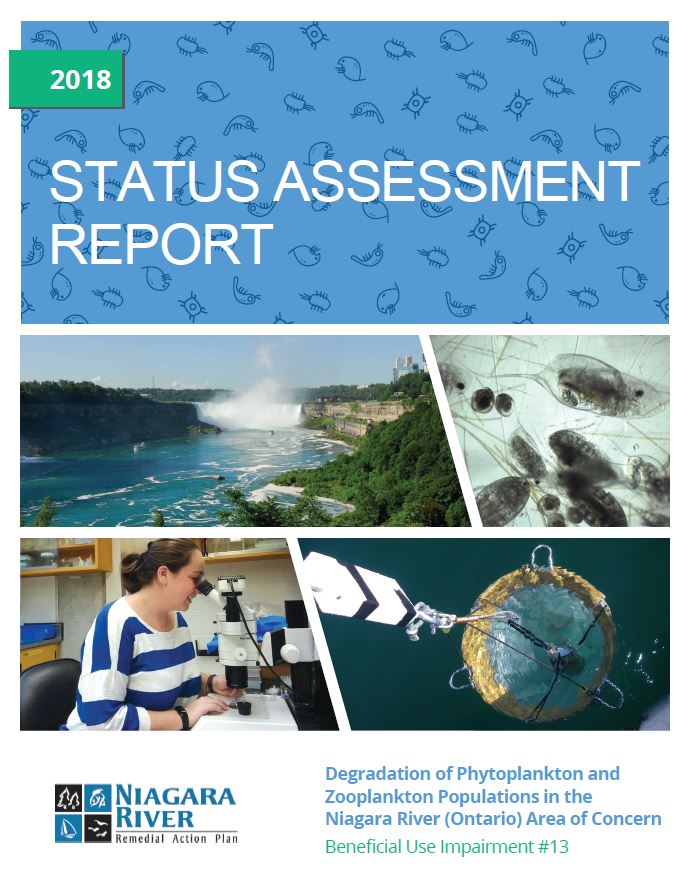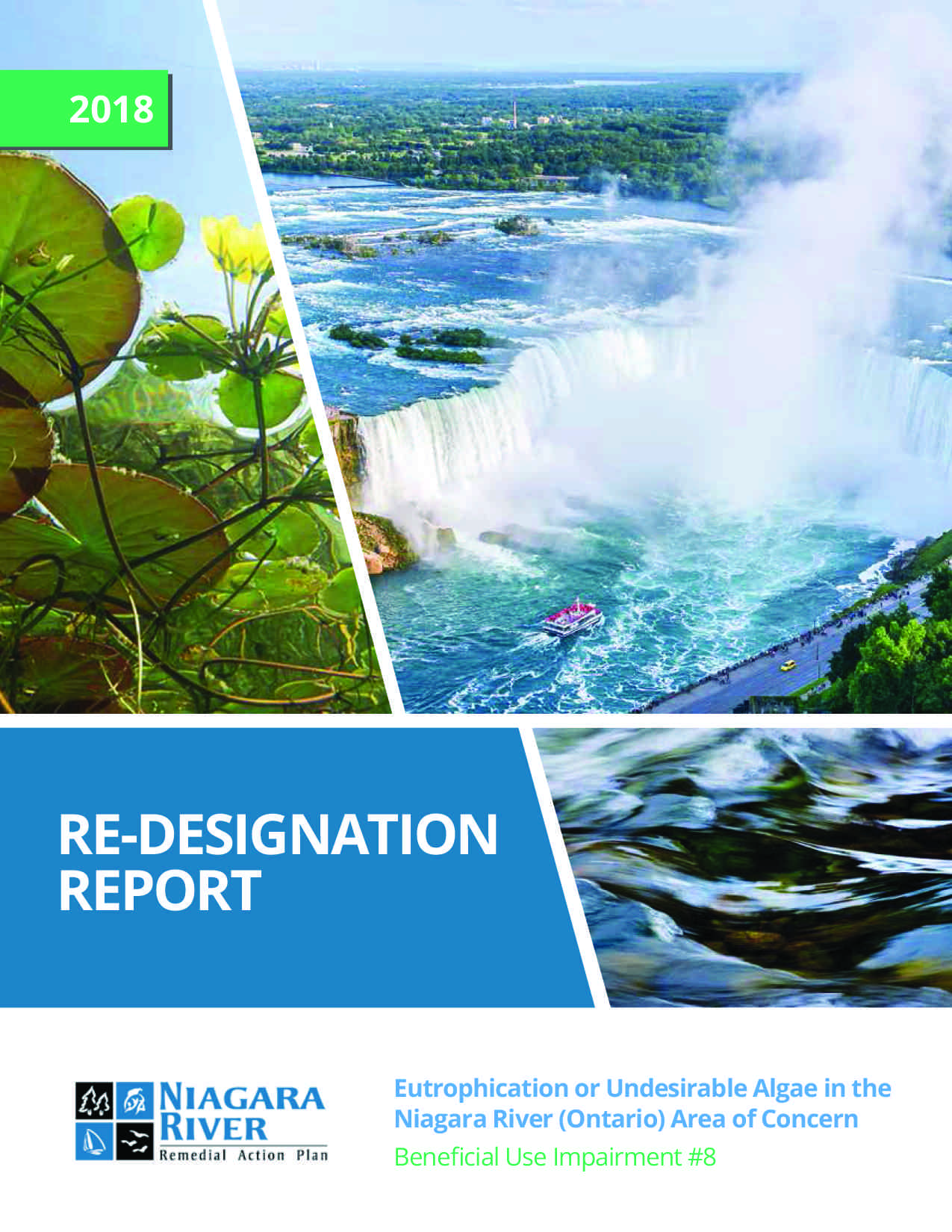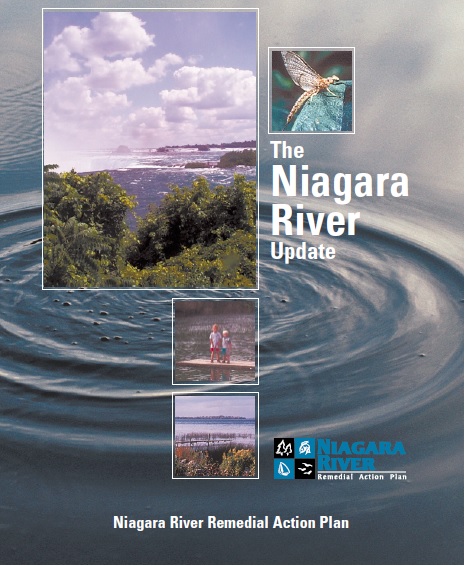The Niagara River Remedial Action Plan (RAP) and its partners have produced numerous reports, updates, and factsheets related to the Niagara River (Ontario) AOC. These documents can be downloaded and/or viewed from this page. All items are searchable or sorted based on their specified categories and tags. Simply enter a keyword in the search box or click on a category or tag to sort items by commons types or topic.
There is also a public repository of RAP documents at the RAP office, housed within the offices of the Niagara Peninsula Conservation Authority (NPCA) in Welland, Ontario. Please contact us should you wish to view these documents in person or to report an error. Thank you.
| Image | Title | Description | Categories | Tags | Year |
|---|---|---|---|---|---|
| PCB Trends in Snapping Turtle Eggs from Lyons Creek East | This report provides insight on PCB contamination trends in Lyons Creek East using common snapping turtles (Chelydra serpentina) as a bio-indicator. Prepared by: K.D. Hughes & S.R. de Solla, Ecotoxicology & Wildlife Health Division, Environment & Climate Change Canada, May 15 2024. | Technical Report | benthos, BUI #6, Lyons Creek East, monitoring, wildlife | 2024 | |
| Sediment/Biological Assessment of Lyons Creek East | This report is a compilation of Ministry of the Environment (MOE) studies on the Polychlorinated Biphenyl (PCB) and metal contamination of Lyons Creek sediments east of the Welland Canal. | Technical Report | benthos, BUI #6, contaminated sediments, Lyons Creek East | 2004 | |
| Lyons Creek East Sediment Transport Study | Purpose: to (1) quantify the sediment input to LCE, to assess the rate of accumulation, and to predict the period of time required to accumulate given a depth of sediment; and (2) determine the max. flow velocity in the system that could be sustained without re-suspending bottom sediments and potentially exposing PCB contaminated sediment to erosion. | Technical Report | benthos, BUI #6, contaminated sediments, LCE, Lyons Creek East, remediation | 2011 | |
| 2021 Lyons Creek East (Niagara River Area of Concern) Sediment Pore Water Survey | Prepared by: M. Graham & J. Peters, Great Lakes Areas of Concern Sediment Remediation Unit, Environment and Climate Change Canada, Apr. 21, 2022. | Technical Report | benthos, BUI #6, LCE, Lyons Creek East, monitoring | 2022 | |
| 2022 Lyons Creek East (Niagara River Area of Concern) Sediment Pore Water Survey | Prepared by: M. Graham & J. Peters, Great Lakes Areas of Concern Sediment Remediation Unit, Environment and Climate Change Canada, Aug 11 2023. | Technical Report | benthos, BUI #6, LCE, Lyons Creek East | 2023 | |
| Lyons Creek East Public Information Centre – Posterboards | A series of informational poster boards displayed at the Lyons Creek East Public Information Centre on May 30, 2023. | Lyons Creek East, poster board | 2023 | ||
| Lyons Creek East Wetland Inventory & Monitoring Study | A detailed inventory of wetland and aquatic features of the Lyons Creek East wetlands. This study incorporated existing background data, remote sensing and field inventories of vascular plants, vegetation communities, breeding amphibians, and breeding birds to catalogue the terrestrial and aquatic resources present, establish baseline conditions, and identify sensitive features and functions. | Lyons Creek East, monitoring, wetland | 2007 | ||
| Beach Closings Beneficial Use Impairment Assessment Report 2021 | The assessment report completed in 2021 summarized key findings showing the improved water quality and recommended the status change. The NPCA sought feedback on the recommendation from the community, Indigenous partners, and U.S. RAP representatives through comprehensive outreach efforts from June 2021 to May 2022. Support for the status change was received before submitting its recommendation to the governments of Canada and Ontario for final approval and removal of the BUI. In March 2023, the NPCA received correspondence from Environment and Climate Change Canada officially confirming the re-designation of this water quality indicator in the Niagara River. | Assessment, BUI Re-designation, Major RAP Report | beach, beach closings, BUI #10, monitoring, Re-designation, water quality | 2023 | |
| Niagara River Mussel Biomonitoring Program: Long-term Water Quality Trends 2012-2018 | Since 1983 the Ontario Ministry of Environment, Conservation, and Parks (MECP) has been committed to the biomonitoring of contaminants in the Niagara River using caged mussels (Elliptio complanata) and more recently using passive samplers and polyethylene devices as part of Ontario’s commitment to the binational Niagara River Toxics Management Plan (NRTMP). These studies have provided information on suspected contaminant sources and source areas between Fort Erie and downstream at the mouth of Niagara-on-the-Lake on both the Canadian and American sides of the river. | Biomonitoring, Mussels, Water Quality | BUI #1, fish consumption | 2022 | |
| Restoring Our River Together: Binational Habitat Efforts | A poster board describing joint efforts on both sides of the Niagara River to improve fish and wildlife habitat. Last updated: 2019. For most recent habitat efforts, contact the RAP (info@ourniagarariver.ca). | Fact Sheet, Poster Board | BUI #14, Fish, habitat, wildlife | 2019 | |
| Delisting Strategy: Niagara River (ON) Area of Concern | This document was developed to provide the most up-to-date summary of information about the Niagara River’s remaining BUIs, provide guidance for applying specific delisting criteria, and identify the remaining priority actions and appropriate lead organization(s) involved in the RAP who will implement the activities for each impairment. | Major RAP Report | BUI #1, BUI #10, BUI #14, BUI #3, BUI #6, Delisting, Implementation, Information, monitoring | 2021 | |
| King Street Investigation & Rehabilitation Final Report 2018-2020 | The report provides an analysis of water quality samples from the storm sewer collection system which discharges to Queens Royal Beach (QRB) located in the Niagara River Area of Concern (AOC), having historical water quality problems. A water quality monitoring program, extensive field investigation program, and rehabilitation of identified infrastructure deficiencies were enacted within the drainage area from 2018 to 2020. | Technical Report | beach, beach closings, BUI #10, monitoring, water quality | 2021 | |
| Queen’s Royal Beach Water Quality: 2020 Monitoring and Data Analysis Report | Summary of 2020 water quality results collected at Queen’s Royal Beach. Over the course of the 2020 sampling season, 90.5% of samples collected at Queen’s Royal Beach (QRB) met the recreational water quality guideline for safe swimming (200 E. coli colony forming units/100 mL or less). Suggested citation: Laufman K. and I. Patel. 2021. Queen’s Royal Beach Water Quality 2019 Monitoring and Data Analysis Report. Town of Niagara-on-the-Lake, Ontario, Canada. | Technical Report | beach, BUI #10, monitoring, water quality | 2021 | |
| Colonial Waterbird Populations and Current Trends | Partial assessment of the Degradation of Fish and Wildlife Populations BUI. This study examined the colonial waterbird populations and current trends in the Niagara River (Ontario) AOC. Results indicate that the relevant criteria have been met and that colonial waterbird populations are NOT IMPAIRED. | Assessment, Technical Report | BUI #3, contaminants, monitoring, waterbirds, wildlife | 2020 | |
| Data Report: Nearshore Fish Community of the upper and lower Niagara River 2015-2017 | Canadian Data Report of Fisheries and Aquatic Sciences 1304. Citation: Gaspardy, R.C., Barnucz, J., and Drake, D.A.R. 2020. Nearshore fish community assessment of the upper and lower Niagara River, 2015 – 2017. Can. Dat. Rep. Fish. Aquat. Sci. 1304: vi + 75 p. | Technical Report | BUI #3, fish community, fish populations | 2020 | |
| Town of NOTL King Street Storm Sewer Investigation | Report on the Town of NOTL storm sewer investigation study to determine the source(s) of contamination in the storm sewer which outlets just upstream of the beach. The study flagged recommendations to address the highest priority issues for remediation. Appendices not attached. | Technical Report | beach, beach closings, BUI #10, water quality | 2019 | |
| Queen’s Royal Beach Water Quality: 2019 Monitoring and Data Analysis Report | Summary of water quality results collected at Queen’s Royal Beach in 2019. Over the course of the 2019 sampling season, 81.1% of samples collected at Queen’s Royal Beach (QRB) met the recreational water quality guideline for safe swimming (200 E. coli colony forming units/100 mL or less). Suggested citation: Laufman K. and P. Moura. 2020. Queen’s Royal Beach Water Quality 2019 Monitoring and Data Analysis Report. Town of Niagara-on-the-Lake, Ontario, Canada. | Technical Report | beach, BUI #10, monitoring, water quality | 2020 | |
| Niagara River Remedial Action Plan – Brochure | Informational brochure about the Niagara River (Ontario) Remedial Action Plan. | Brochure, Education & Outreach | About, Education, Information | 2017 | |
| Biomonitoring Study of Lyons Creek East (2002-2003) | A joint study was undertaken by Environment and Climate Change Canada, and the Ministry of the Environment, Conservation and Parks to address and document the sediment and water quality in Lyons Creek East. The study was undertaken in 2 parks; 1. a screening survey to identify areas with elevated PCBs, and 2. a survey that included sediment cores, caged mussels, and fish collections to understand the contamination of PCBs within the ecosystem. The study found that PCB contamination in the upper portion of LCE is elevated in all media (i.e. sediment, mussels, forage fish and sport fish) and concentrations in all media exceed their respective guidelines at more than one location. The data suggest that the extremely high levels of PCBs observed in the upstream sediments are mobile, bioavailable to the biota, and may potentially be toxic to sediment dwelling organisms. The study also details the extent of the PCB contamination and information about the type of PCB found. Suggested citation: Fletcher, R., and S. Petro. 2005. Biomonitoring study of Lyons Creek East, Welland Ontario. 2002-2003. Technical Memorandum to West Central Region. Ministry of the Environment, ON, Canada. March 2005. 79 pp. | Technical Memorandum | benthos, BUI #6, LCE, Lyons Creek East, monitoring, research | 2005 | |
| Lyons Creek East Long Term Monitoring Plan to Assess Monitored Natural Recovery as an Effective Remediation Strategy: 2015 Survey | Prepared by Lisa Richman, Ontario Ministry of Environment, Conservation and Parks (Nov. 2018). | Technical Memorandum | BUI #6, contaminants, LCE, Lyons Creek East, monitoring | 2018 | |
| The Assessment of Sediment PCB Contamination and Biological Impacts in Lyons Creek East (Niagara River Area of Concern) | This report describes sediment and biota quality in Lyons Creek East (Niagara River Area of Concern) from 2002-2003. Prepared by Danielle Milani and Lee Grapentine, Environment Canada, Aquatic Ecosystem Impacts Research Branch, NWRI Contribution No. 06-414 | Technical Report | benthos, BUI #6, LCE, Lyons Creek East, monitoring | 2006 | |
| Lyons Creek East (Niagara River, Ontario) Area of Concern: benthic conditions in 2015 and temporal trends from 2002 to 2015 | Report on the results of sediment chemistry, benthic community structure, bioaccumulation in native invertebrates, and sediment toxicity from fall 2015 sampling at Lyons Creek East and three nearby reference sites. Analysis also includes trends from 2002-2015. Prepared by Danielle Milani and Lee Grapentine, Environment and Climate Change Canada, Water Science and Technology Directorate, March 2017 | Technical Report | benthos, BUI #6, LCE, Lyons Creek East, monitoring | 2017 | |
| Benthic Conditions in Lyons Creek East (Niagara River Area of Concern) 2002 – 2010 | Report on the results from Environment Canada’s sampling efforts at Lyons Creek East as part of the monitored natural recovery which was selected as the option for the management of the contaminated sediments. Prepared by D. Milani and L. Grapentine, Environment Canada, Watershed Hydrology and Ecology Division, March 2014. | Technical Report | benthos, LCE, Lyons Creek East, monitoring | 2014 | |
| Toxic Contaminants in the Niagara River 1975-1982 | This report summarizes results of monitoring for toxic contaminants and trace metals in the Niagara River between 1975 and 1982. | Technical Report | archive, contaminants, historic, monitoring, research | 1984 | |
| Summary: Eutrophication or Undesirable Algae BUI | Plain-language summary to communicate the results of the technical assessment report on the Niagara River’s eutrophication or undesirable algae BUI. | Education & Outreach, Fact Sheet | Algae, BUI #8, Eutrophication, Re-designation | 2017 | |
| Summary: Phytoplankton and Zooplankton Populations BUI | Plain-language summary to communicate the results of the technical assessment report on Niagara River plankton populations. | Education & Outreach | BUI #13, Phytoplankton, Plankton, Zooplankton | 2017 | |
| Niagara River Biomonitoring Study 2015: Caged Mussels and Semi-Permeable Membrane Devices | Updated with Addendum in 2022. Niagara River Biomonitoring Study 2012: Caged Mussels and Semi Permeable Membrane Devices (SPMDs). Prepared by Lisa Richman, Ontario Ministry of Environment, Water Monitoring Section, Environmental Monitoring and Reporting Branch, Nov. 2015 | Technical Report | caged mussels, monitoring, NRTMP | 2018 | |
| Annual Progress Update 2017-2018 | Progress report on priority actions to advance the Niagara River Remedial Action Plan in 2017-2018. | Annual Report | AOC Update | 2018 | |
| Status Assessment Report: Phytoplankton and Zooplankton Populations in the Niagara River Area of Concern | The report includes the technical assessment and all public engagement that supported the change of status of the Phytoplankton and Zooplankton Populations BUI in the Niagara River to ‘Not Impaired’ (from ‘Requires Further Assessment’). The Canada-Ontario Agreement Annex 4 Co-leads formally confirmed the ‘Not Impaired’ designation in January 2019. | BUI Re-designation | Algae, BUI #13, monitoring, Phytoplankton, Plankton, research, Zooplankton | 2018 | |
| Re-Designation Report: Eutrophication or Undesirable Algae in the Niagara River Area of Concern | The report includes the technical assessment and all public engagement that supported the change of status of the Eutrophication or Undesirable Algae BUI in the Niagara River to ‘Not Impaired’ (from ‘Impaired’). The Canada-Ontario Agreement Annex 4 Co-leads formally confirmed the ‘Not Impaired’ designation in May 2019. | BUI Re-designation | Algae, BUI #8, Eutrophication, Re-designation | 2018 | |
| Niagara River Biomonitoring Study 2012: Caged Mussels and Semi Permeable Membrane Devices (SPMDs) | Updated with Addendum in 2022. Niagara River Biomonitoring Study 2012: Caged Mussels and Semi Permeable Membrane Devices (SPMDs). Prepared by Lisa Richman, Ontario Ministry of Environment, Water Monitoring Section, Environmental Monitoring and Reporting Branch, Nov. 2015 | Technical Report | caged mussels, monitoring, NRTMP | 2015 | |
| Niagara River Watershed Fish Community Report | The purpose of this project was to describe resident (June to Oct) fish communities (fish species and relative abundances) in the Niagara River watershed in relation to indicators of habitat quality, ecosystem quality and overall biologic diversity. Citation: Yagi A.R and C. Blott. 2012. Niagara River Watershed Fish Community Assessment (1997 to 2011) Ontario Ministry of Natural Resources unpublished report 168pp + appendices | Technical Report | fish populations, habitat, watershed | 2012 | |
| Niagara River Upstream/Downstream Program Report: Concentrations, Loads and Trends | Results from the Niagara River Upstream/Downstream program to measure the concentrations/loads and trends of contaminants in the river, 2001-02 & 2004-05. Data are compared to the most stringent water quality criteria available from the four agencies, to provide an indication of potential impairment of beneficial uses. Use of these data for any other purpose is at the discretion of the user. | Technical Report | contaminants, monitoring, NRTMP, Upstream-Downstream | 2009 | |
| Monitoring & Assessing Marsh Habitat Health | Bird Studies Canada final project report to assess AOC wetland quality and enhance long-term volunteer monitoring within the region. The primary goal of this project was to integrate Marsh Monitoring Program bird and amphibian data with limnological and aquatic macroinvertebrate data to provide a multi-parameter assessment of wetland health for the Niagara River AOC to inform the current status of BUI #3 (Degradation of Fish & Wildlife Populations). | Technical Report | BUI #3, marsh, monitoring, wetlands, wildlife | 2010 | |
| Niagara River AOC Aquatic Wildlife Status Report -November 24, 2010 (final) | 2010 | ||||
| Welland River Eutrophication Study Final Report Appendices | |||||
| Welland River Eutrophication Study Final Report – March 2011 | The 2007 Welland River Eutrophication Study was conducted to address data gaps and to outline the various monitoring requirements. Included in this report is the study design, methods and conclusion; the delisting criteria in relation to the findings from the study and recommendations for the RAP Coordinating Committee. | BUI #8, Eutrophication, monitoring, water quality, Welland River | 2011 | ||
| Lyons Creek East PCB Decay Report | This report by Golder & Associates reviews the theoretical decay of Polychlorinated Biphenyls (PCBs), assesses available data for PCB decay in Lyons Creek East, and describes the predicted decay of PCBs in Lyons Creek East. The study predicts that based on a range of dechlorination rates provided by Magar et al. (2005b) from their work at Lake Hartwell, it could take 41 years at the average rate and up to 109 years at the maximum rate. It is not known whether the rate of PCB decay is similar to the rate of decay measured in Lake Hartwell. | 2011 | |||
| PCB contamination and biological impacts in Lyons Creek East: Implementation of a Canada-Ontario Decision-making framework for contaminated sediments | This report describes sediment and biota quality in Lyons Creek East from sampling conducted in 2002 and 2003. Prepared by D. Milani (National Water Research Institute, Environment Canada) and R. Fletcher (Biomonitoring Section, EMRB, Ontario Ministry of the Environment), March 2006. | Technical Report | benthos, BUI #6, LCE, Lyons Creek East, monitoring | 2006 | |
| Lyons Creek West – Human Health Risk Assessment | A Human Health Risk Assessment (HHRA) was undertaken to determine the potential health risks for people who may come into contact with contaminants that originate from Lyons Creek West. The HHRA for Lyons Creek West was focused on the presence of PCBs and metals in the soil and sediment at the site. The assessment concluded that exposure to contaminants in the Upland area and in sediments in the Wetland area would not pose a potential concern for human health, based on the exposure estimates used in this risk assessment. | 2007 | |||
| Lyons Creek East Human Health Risk Assessment (HHRA) | The Human Health Risk Assessment (HHRA) conducted for Lyons Creek East focused on potential exposure to PCBs in the study area. A community survey was conducted with the participation of residents in the Lyons Creek East study area to establish the number of people who catch and eat fish and game from the area, as well as use the creek recreationally. An assessment of both dermal exposure to PCBs and exposure to PCBs through consumption of fish was conducted. Based on the exposure estimates used in this assessment, the results suggest that remediation of the Lyons Creek East study area to address potential human health concerns is not warranted. | 2007 | |||
| Lyons Ck East Evaluation of Adm Control | 2011 | ||||
| Lyons Ck East Protocol | 2011 | ||||
| Lyons Ck East Guide | 2011 | ||||
| Niagara AOC Golder BUI Assessment April 2013 | 2013 | ||||
| Lyons Creek East & West Sediment Management Options (2008) | Sediment management options discussion paper for Lyons Creek East and West developed in 2008. | Technical Report | benthos, contaminants, LCE, Lyons Creek East | 2008 | |
| Niagara River Sediment Study Phase 3 | |||||
| Niagara River AOC Contaminated Sediment Study Phase 1&2 | A review of sediment conditions in 12 sites within the Niagara River Area of Concern (watershed) was undertaken as a move towards de-listing the area. The focus of the study was to determine whether additional investigation was needed at any of the sites with a view towards identifying those areas where remediation may be required. Author: Golder Associates | Technical Report | benthos, BUI #6, contaminants, Lyons Creek East | 2004 | |
| Niagara River AOC Update – 2012 | Niagara River AOC Update 2012 – English only | Fact Sheet | AOC Update | 2012 | |
| Niagara River AOC Update 2010 – French | AOC Update 2010 – French | Fact Sheet | AOC Update | 2010 | |
| Niagara River AOC Update 2010 – English | AOC Update 2010 – English | Fact Sheet | AOC Update | 2010 | |
| Niagara River AOC Update – 2002 | Niagara River AOC Update – 2002 (English Only) | Fact Sheet | AOC Update | 2002 | |
| Niagara River RAP Stage 2 Update Report | An update to the Niagara River RAP Stage 2 Report. This document outlines progress made since the 1995 Stage 2 Report was released, provides recommendations for actions toward delisting, and updates the status and delisting criteria for several beneficial use impairments. | Major RAP Report | Stage 2 Update | 2009 | |
| Niagara River RAP Implementation Annex | The Implementation Annex completes the RAP Stage 2 Report. The Annex identifies agencies that are responsible for implementing recommendations, and provides a schedule of activities, timelines and projected costs. The Implementation Annex was replaced by the Stage 2 Update in 2009. | Major RAP Report | Implementation, Stage 2 Update | 2000 | |
| Niagara River RAP Stage 2 Report: The Cleanup Connection | This document completed in 1995 provides recommended options to achieve delisting the Niagara River (Ontario) AOC. | Major RAP Report | Stage 2 | 1995 | |
| Niagara River RAP Stage 1 Update: Environmental Conditions and Problem Definition | This document updates the 1993 Stage 1 RAP Report after formal reviews by the federal and provincial governments and the International Joint Commission which identified missing information or data gaps. | Major RAP Report | Stage 1 Update | 1995 | |
| Niagara River RAP Stage 1 Report: Environmental Conditions and Problem Definition | Identification of environmental conditions and problems in the Niagara River (Ontario) AOC as well as the establishment of the original beneficial use impairments. | Major RAP Report | Stage 1 | 1993 | |
| Fish Tumor Assessment Canadian Lower Lakes – March 2010 | A report on the prevalence of fish tumours at several Areas of Concern in the lower Great Lakes Canadian whose BUI status was ‘Impaired’ or ‘Unknown’. The report indicated the BUI is ‘Not Impaired’ for the Niagara River AOC. | BUI Re-designation, Technical Report | BUI #4, Fish, Tumours | 2010 | |
| Fish Barrier Project: Fish Population Data Analysis Report | Report on the Fish Barrier Project by the Niagara Restoration Council. For the first time, both private and public fish barriers were inventoried, assessed, and a grant program created to help in their removal. The project has exceeded the goal of removing 75% of the potential barriers to fish migration in the Niagara River watershed. | Technical Report | BUI #3, fish populations, habitat | 2010 | |
| Special Report on Pollution in the Niagara River | A special report by the International Joint Commission under the 1978 Great Lakes Water Quality Agreement on the pollution in the Niagara River. January 20, 1981. | Technical Report | contaminants, historic, IJC | 1981 |

